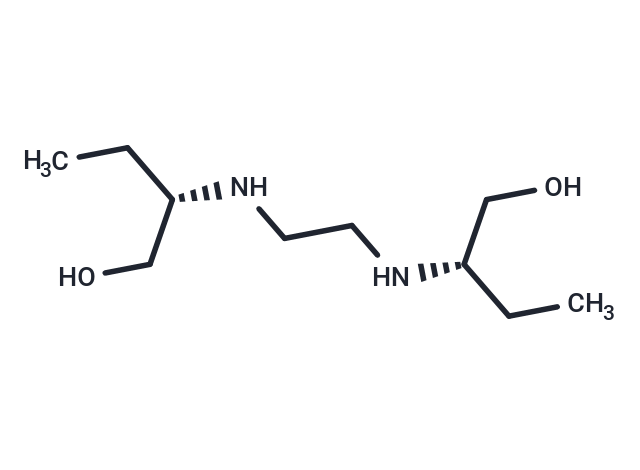Shopping Cart
Remove All Your shopping cart is currently empty
Your shopping cart is currently empty
Ethambutol is an oral anti-tuberculosis drug that inhibits arabinosyl transferase activity, thereby interfering with the synthesis of arabinogalactan and preventing cell wall formation to exert its antibacterial effect; it can also be used for animal models of hyperuricemia and optic neuropathy.

| Pack Size | Price | USA Warehouse | Global Warehouse | Quantity |
|---|---|---|---|---|
| 5 mg | $31 | - | In Stock | |
| 10 mg | $54 | - | In Stock | |
| 25 mg | $109 | - | In Stock | |
| 50 mg | $185 | - | In Stock | |
| 100 mg | $313 | - | In Stock | |
| 1 mL x 10 mM (in DMSO) | $35 | - | In Stock |
| Description | Ethambutol is an oral anti-tuberculosis drug that inhibits arabinosyl transferase activity, thereby interfering with the synthesis of arabinogalactan and preventing cell wall formation to exert its antibacterial effect; it can also be used for animal models of hyperuricemia and optic neuropathy. |
| Targets&IC50 | HCT116 cells:5.5±1.0 µg/mL, SW480 cells:5.8±1.3 µg/mL, HT29 cells:25.5±4.7 µg/mL, MCF-7 cells:11.1±1.1 µg/mL, SW620 cells:5.5±2.1 µg/mL, DLD1 cells:7.8±2.2 µg/mL |
| In vitro | The MTT or CCK-8 assays showed that Ethambutol (0-50µg/mL) exerted a time-dependent inhibitory effect on cell proliferation in six cell lines, including SW480 and SW620. The IC50 values for different cell lines ranged from 5.37 to 31.54µg/mL over 24-72 hours[1]. In the RGC-5 retinal ganglion cell experiment, after treating the cells with 4mM Ethambutol for 8 hours, flow cytometry and Western blot analysis confirmed a significant increase in cell apoptosis, as well as upregulation of autophagy markers such as PI3C3 and Beclin-1[2]. Additionally, treatment of Mycobacterium smegmatis with 10µg/mL Ethambutol followed by acid hydrolysis combined with HPLC and enzyme activity analysis showed changes in arabinogalactanase activity[3]. |
| In vivo | Ethambutol (250 mg/kg, administered by gavage once daily for 23 days) can induce hyperuricemia and cause pathological damage and inflammatory reactions in the thymus and spleen, manifested by thymic atrophy, fusion of the cortex and medulla, congestion of the splenic sinuses, and hemosiderin deposition [4,5]. In addition, Ethambutol (35 mg/kg/day, orally for 30 days) can induce optic neuropathy, leading to ganglion cell damage, increased retinal ganglion cell (RGC) density, and thickening of the RGC layer [6]. |
| Synonyms | Myambutol, EMB |
| Molecular Weight | 204.31 |
| Formula | C10H24N2O2 |
| Cas No. | 74-55-5 |
| Smiles | [C@H](NCCN[C@@H](CC)CO)(CC)CO |
| Relative Density. | 1.0048 g/cm3 (Estimated) |
| Storage | keep away from moisture,keep away from direct sunlight | Powder: -20°C for 3 years | In solvent: -80°C for 1 year | Shipping with blue ice/Shipping at ambient temperature. | |||||||||||||||||||||||||||||||||||
| Solubility Information | DMSO: 80 mg/mL (391.56 mM), Sonication is recommended. H2O: 180 mg/mL (881.01 mM), Sonication is recommended. | |||||||||||||||||||||||||||||||||||
Solution Preparation Table | ||||||||||||||||||||||||||||||||||||
DMSO/H2O
| ||||||||||||||||||||||||||||||||||||
| Size | Quantity | Unit Price | Amount | Operation |
|---|

Copyright © 2015-2025 TargetMol Chemicals Inc. All Rights Reserved.